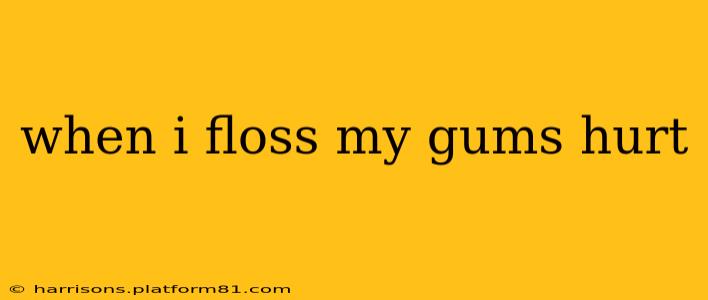Many people experience gum pain when they start flossing, or even after years of consistent flossing. This discomfort isn't necessarily a sign that you're doing something wrong; instead, it often points to underlying gum health issues that need attention. Understanding the causes can help you alleviate the pain and maintain optimal oral hygiene.
Why Do My Gums Hurt When I Floss?
The pain you feel when flossing is usually a symptom of gum inflammation, known as gingivitis. This inflammation is often caused by plaque buildup along the gum line. When you floss, you're disrupting this plaque, which can temporarily irritate the already inflamed gums. Several factors contribute to this:
-
Gingivitis: The most common cause. Gingivitis is the early stage of gum disease, characterized by red, swollen, and bleeding gums. It's typically caused by inadequate oral hygiene, allowing plaque to accumulate.
-
Aggressive Flossing: Using excessive force while flossing can traumatize the gum tissue, leading to pain and bleeding. Gentle and careful flossing is crucial.
-
Improper Flossing Technique: Incorrect flossing technique can also damage the gums. Snapping the floss between the teeth or forcing it too aggressively can injure the gum tissue.
-
Underlying Gum Disease (Periodontitis): If gingivitis is left untreated, it can progress to periodontitis, a more severe form of gum disease that damages the tissues and bone supporting your teeth. Flossing may be painful in this case due to the advanced inflammation and potential gum recession.
What Should I Do If My Gums Hurt When I Floss?
Don't avoid flossing altogether! Ignoring the problem will only worsen the inflammation. Instead, try these steps:
-
Switch to a Softer Floss: If you're currently using waxed floss, try unwaxed floss, or vice-versa. Experiment with different types to find one that's gentler on your gums. Consider floss picks, which can be easier to handle for some people.
-
Use the Correct Technique: Ensure you're flossing correctly. Gently guide the floss between your teeth, curving it around each tooth in a "C" shape to reach below the gum line. Avoid snapping the floss.
-
Increase Flossing Frequency Gradually: If you're new to flossing, start by flossing once a day, focusing on one section of your mouth at a time. Gradually increase the frequency as your gums become more accustomed to it.
-
Improve Overall Oral Hygiene: Brush your teeth twice daily with fluoride toothpaste, using proper brushing techniques. This will reduce plaque buildup and help prevent gingivitis.
-
Rinse with Antiseptic Mouthwash: An antiseptic mouthwash can help reduce bacteria and inflammation. Follow the instructions on the product label carefully.
-
Consult Your Dentist: Persistent gum pain despite trying these remedies warrants a visit to your dentist. They can diagnose the underlying cause of your gum pain and recommend appropriate treatment, which might include professional cleaning or other therapeutic interventions.
How Can I Prevent Gum Pain When Flossing?
Preventing gum pain requires consistent and proper oral hygiene:
-
Floss Daily: Make flossing a regular part of your daily oral care routine.
-
Use Gentle Pressure: Avoid using excessive force when flossing.
-
Master the Proper Technique: Learning the correct flossing technique is vital. Your dentist or hygienist can demonstrate the correct technique and answer any questions.
-
Regular Dental Checkups: Schedule regular checkups and professional cleanings with your dentist. This will help detect and address gum problems early on, preventing more serious issues.
Is Bleeding Gums When Flossing Normal?
Some bleeding when you first start flossing is common, as it indicates that you're reaching areas where plaque and bacteria have accumulated. However, persistent bleeding is not normal and suggests a need for improved oral hygiene or professional dental care. If bleeding continues, consult your dentist.
How Long Does It Take for Gums to Heal After Flossing?
The healing time varies depending on the severity of gum inflammation. With consistent proper flossing and good oral hygiene practices, you should notice a reduction in gum pain and bleeding within a few days to a couple of weeks. If the pain persists or worsens, seek professional dental advice.
In conclusion, while gum pain when flossing can be frustrating, it's a sign that you need to pay closer attention to your oral hygiene. By following these tips and seeking professional help when necessary, you can keep your gums healthy and maintain a beautiful smile. Remember, prevention is always better than cure!
